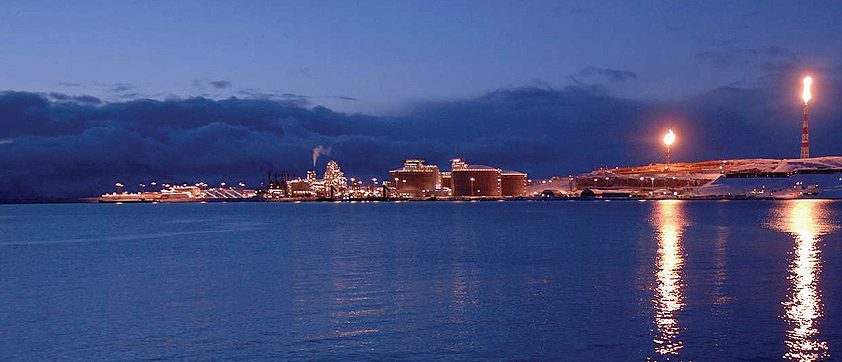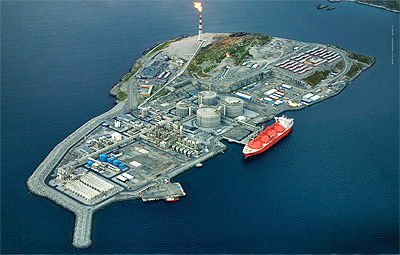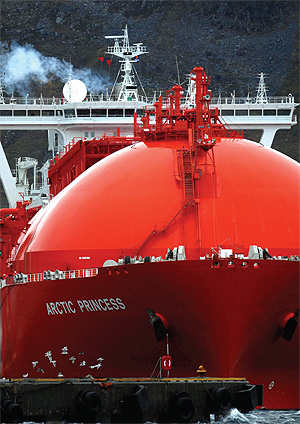
StatoilHydro – Snøhvit
A true adventure
With a price tag of NOK 58 billion, the Snøhvit plant at Melkøya outside Hammerfest in Norway ranks as the largest-ever industrial development in northern Norway.
It has contributed substantial value creation and expertise at local and regional level, and created some 350-400 new jobs in Hammerfest, including 220 in StatoilHydros operation team at the gas liquefaction plant. The plant is set to remain operational for 30-35 years, and aims to tap into recoverable reserves of 193 billion cubic metres of natural gas, 113 million barrels of condensate (light oil), and 5.1 million tonnes of natural gas liquids (NGL), in water depths of 250-345 metres.
After five years of development, StatoilHydro commenced production of liquefied natural gas (LNG) at the Hammerfest LNG plant on 13 September 2007. “Snøhvit is a fantastic industrial  adventure we’ve been working on for many years,” says Tim Dodson, acting executive vice president for Exploration & Production Norway (EPN). “The start-up of LNG production 24 years after the discovery of the Barents Sea’s Snøhvit field is one of the absolute highlights in the project.”
adventure we’ve been working on for many years,” says Tim Dodson, acting executive vice president for Exploration & Production Norway (EPN). “The start-up of LNG production 24 years after the discovery of the Barents Sea’s Snøhvit field is one of the absolute highlights in the project.”
Also embracing the Albatross and Askeladd fields, the Snøhvit project represents the first wholly subsea development on the Norwegian continental shelf (NCS), with no offshore installations visible on the surface. The fields are tied to the land-based plant by several links, with the largest of these being the gas pipeline, which is 143 kilometres long and has an internal diameter of 65.5 centimetres. In addition there are two chemical lines, an umbilical and a separate pipeline for transporting carbon dioxide.
Snøhvit’s subsea installations are operated via the umbilical. Both subsea production on the field and pipeline transport will be monitored and controlled from the control room at the gas liquefaction plant on Melkøya. Operators will be able to open and close valves on the seabed 150 kilometres away with signals transmitted along fibre-optic cables, and with high-voltage electrical and hydraulic power lines. All communication between the control room and subsea installations will take place through the umbilical.
Because Snøhvit was the first offshore development in the Barents Sea, as well as being Europe’s first export facility for liquefied natural gas (LNG) production and the landing of natural gas from the Snøhvit, Albatross and Askeladd fields, it has naturally come across some challenges – in particular, the health, safety and environmental (HSE) aspects of the project have required special attention. StatoilHydro placed particular emphasis on safety and the environment in designing the technical solutions, and its HSE target for Snøhvit is that its development and production will cause zero accidents, lost-time injuries, occupational illnesses, material loss or damage to the environment. More assessment studies have been carried out for Snøhvit than on any other project  StatoilHydro has so far sought to develop.
StatoilHydro has so far sought to develop.
As the operator of this project, StatoilHydro also aims to produce the field and its land-based facilities at Melkøya without harmful discharges to the sea. A biological treatment plant on land will deal with environmentally harmful components, and carbon dioxide in the wellstream is being separated out on land, piped back to the field and stored underground.
Another factor considered by StatoilHydro is the impact that the project could have on the important fishing industry in these waters. As a result of an extensive dialogue with relevant parties, none of its installations will interfere with fishing, and the subsea facilities can be overtrawled. This project demonstrates that the oil and gas industry can co-exist with the fishing sector, if the negotiation process is handled correctly.
Not only does the project represent the newest technology and approaches, but also new business opportunities. Deliveries from the Snøhvit development will provide StatoilHydro with its entry ticket to the fast-growing US market for natural gas. An annual volume of 2.4 billion cubic metres of liquefied natural gas (LNG) is due to be shipped to the Cove Point receiving terminal in Maryland after the field comes on stream. Spain represents another important market for StatoilHydro, and 1.6 billion cubic metres of Snøhvit gas will be shipped to that country every year. The French licensees in the field, Gaz de France and Total, are responsible for exporting their own share of the gas. This totals 1.7 billion standard cubic metres per year.
To ship the gas from the Snøhvit liquefaction plant to the receiving terminals has required the procurement of specially built LNG carriers. These carriers have been built to the strictest environmental and safety standards at yards in Japan and France. The vessels are 290 metres long and have an LNG cargo capacity of about 140,000 cubic metres. When the plant is in full production, one special carrier will arrive at Melkøya every five or six days to collect LNG and transport it to customers in Europe and the US.
Adopting new technology has allowed StatoilHydro to achieve what few people had thought possible – the first offshore development in the Barents Sea. For StatoilHydro, the Snøhvit project marks the first stage in an exciting and challenging move into offshore operations in far northern waters – and has proved that challenges can be overcome, providing you have the passion and energy to pursue your goals.
StatoilHydro – Snøhvit
Project: Offshore development in the Barents Sea